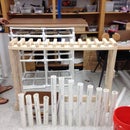Introduction: How to Play Guitar
Materials needed: A guitar
Step 1: Get Started
Get a guitar and make sure it is in standard tuning (EADGBE)
Step 2: The Strings
Familiarize yourself with which string is what note by playing them from the top string down to the bottom one at a time. Know the names of the strings in order (EADGBE)
Step 3: Frets
Familiarize yourself with the frets. You can see clearly each fret on the guitar therefore if I say put your pointer finger on the high E 2nd fret, then you know what to do.
Step 4: D Chord
Now you know the different frets and strings. Lets learn some chords. The first chord to learn can be D. To play a D put your pointer finger on the G string 2nd fret. Then Put your ring finger on the B string 3rd fret. Finally, put your pointer finger on the high E string on the 2nd fret. Strum the bottom four strings, leaving out the low E and A. Thats a D chord.
Step 5: The G Chord.
Put your pinky finger on the high E string 3rd fret. Put your middle finger on the A string 2nd fret. Finally, put your pointer finger on the low E string 3rd fret. Strum all of the strings. Thats a G chord.
Step 6: The C Chord.
Put your pointer finger on the B string first fret. Then put your middle finger on the D string 2nd fret. Finally, put your ring finger on the A string 3rd fret. Strum all of the strings. That’s a C chord.
Step 7: The Em Chord.
Em stands for E minor. Well learn the E chord later but for now E minor is slightly easier and is more commonly used. First put your middle finger on the A string 2nd fret. Then put your ring finger on the D string 2nd fret. Strum all of the strings. Thats a Em chord.
Step 8: The a Chord.
First put your middle finger on the D string 2nd fret. Then put your middle finger on the G string 2nd fret. Finally, put your ring finger on the B string 2nd fret. Strum all of the strings. Thats an A chord.
Step 9: The Am Chord.
Am stands for A minor. First put your middle finger on the D string 2nd fret. Then put your ring finger on the G string 2nd fret. Finally, put your pointer finger on the B string 1st fret. Strum all of the strings. Thats an Am.
Step 10: The E Chord.
First put your middle finger on the A string 2nd fret. Then put your ring finger on the D string 2nd fret. Finally, put your pointer finger on the G string 1st fret. Strum all of the strings. Thats an E.
Step 11: The F Chord.
The F chord is slightly more difficult than others. To play an F chord first put your pointer finger on both the high E string and the B string first fret. Put your middle finger on the G string 2nd fret. Then put your middle finger on the A string 3rd fret. Finally, put your pinky finger on the D string 3rd fret. Strum all of the strings. Thats an F.
Step 12: The F# and F#m Chords.
F# stands for F sharp and F#m stands for F#m. To play an F# simply take the same fingering you have for an F and move it all down one fret. Then to play an F#m keep your ring finger and your pinky finger in the same position and then Barr all the strings on the 2nd fret. Barring can be very difficult for a beginner and may take a lot of practice so don’t get frustrated.
Step 13: The Bm Chord.
Bm stands for B minor. First put your pointer finger on the high E string 2nd fret. Then put your middle finger on the B string 3rd fret. Then put your ring finger on the D string 4th fret. Finally, put your pinky finger on the G string 4th fret. Strum every string except for the low E string. Thats a Bm. Take that same shape and move it down the fret boards to play every single minor chord on the scale. As you slide your fingers down the order goes: Bm, C#m, Cm, D#m, Dm, E#m, Em, F#m, Fm, G#m, Gm.
Step 14: The D7 Chord.
First put your middle finger on the G string 2nd fret. Then put your pointer finger on the B string first fret. Finally, put your ring finger on the high E string 2nd fret.
Step 15: The A7 Chord.
Play an A chord without the ring finger.
Step 16: The E7 Chord
Play the E chord without the ring finger.











